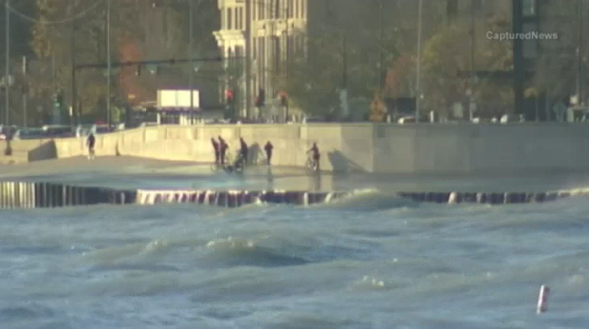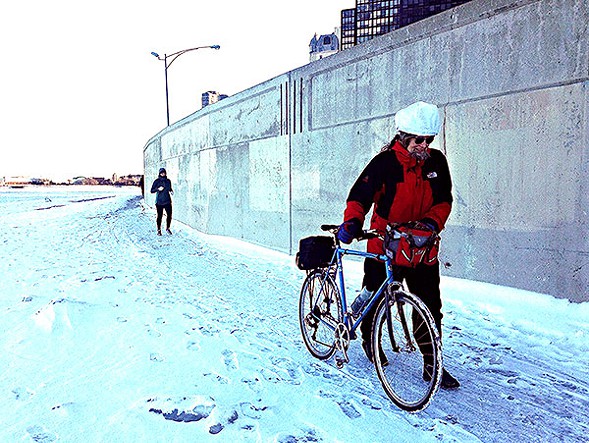[The Chicago Reader recently launched a weekly transportation column written by Streetsblog Chicago editor John Greenfield. This partnership allows Streetsblog to extend the reach of our livable streets advocacy. We syndicate a portion of the column after it comes out online; you can read the remainder on the Reader’s website or in print. The paper hits the streets on Thursdays.]
Maybe they should call it Dead Man's Curve. Just southeast of Oak Street Beach, there's a bend in the Lakefront Trail where it turns south, hugging Lake Shore Drive. As you head downtown, there's a wall on your right, and the path's concrete surface slopes down toward the water's edge, where there's a sheer drop of several feet into Lake Michigan.
During the winter, this hump of land is pounded by waves. After it snows, the waves turn the path into an arctic wasteland of ice boulders, forcing bike riders to dismount and walk their steeds or detour to Inner Lake Shore Drive. At other times, the surf transforms the trail into an angled skating rink that's also a serious hazard. The curve is especially dangerous for southbound riders, who often fail to see the slick conditions before they round the blind curve. By then it's usually too late to hit the brakes.
When such conditions exist, the Chicago Park District, which is responsible for maintaining the bikeway, barricades the curve with sawhorses and sends out alerts on Twitter that the section of lakefront is closed. But bike riders like Joe DeCeault hope a permanent solution can be found to fix the most perilous spot on the 18.5-mile-long trail.
DeCeault, who works as a Web producer for WBEZ, knows all too well what a death trap the ice-glazed incline can be. In February 2012, during his first season of winter biking, he was doing a training ride on a skinny-tired road bike on a particularly windy morning.
Convinced by what he saw farther north that the curve would be ice free, he confidently rounded the bend at a high speed. Then he looked down and saw he was entering a long, slippery stretch. He realized he had to pump his brakes. "As I did, I noticed the wheels start to slide," he wrote in an e-mail. "My body and bike tilted sideways. Shit!"
DeCeault fell from his bike and landed hard on his side and stomach. "It stung like a b----," he recalled. "I grabbed at the ground to halt my journey towards the lake." He came to a stop, but when he lifted his head, he saw his bike continue to slide towards the edge of the path. "My bike kept going and going and going until—bloop—it dropped off the edge of the concrete and into the lake."

DeCeault is far from the only local cyclist to crash due to perilous conditions at the Oak Street curve. An NBC Chicago clip from January 2014 showed 18 riders wiping out on black ice at the spot, sometimes two at a time, over the course of a few minutes.
The mayhem resembles something out of a Keystone Cops flick. "There goes another one, down, down, down," chuckles the cameraman.
The persistence of the problems isn't so funny. I checked out the path in the middle of last week, a few days after a couple inches of snow had fallen. The Oak Street curve was shellacked with ice and snow, and the trail was barricaded between the beach and the construction site of the Navy Pier Flyover. This $60 million elevated path will soar over Grand Avenue and Illinois Street, eliminating a dangerous trail bottleneck. Much of this stretch was impassable for bike riders, and treacherous for people walking and jogging.
In addition to the flyover, the city recently completed the $31.5 million Fullerton Revetment project, which built 5.8 acres of new lakefront parkland at Fullerton Avenue, and relocated a section of the trail so it's less exposed to waves.
So are there any plans to fix the Oak Street curve problem in the long term?





